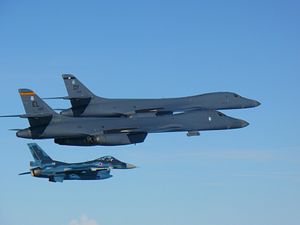Two B-1B Lancer heavy strategic bombers from Andersen Air Force Base on Guam in the Western Pacific conducted sequenced bilateral training missions with the Japan Air Self-Defense Force (JASDF) and Republic of Korea Air Force (ROKAF) on July 29 in response to North Korea’s purported second-ever flight-test of the Hwasong-14/KN20 intercontinental ballistic missile (ICBM) on July 28.
The bilateral training missions are “in direct response to North Korea’s escalatory launch of intercontinental ballistic missiles on July 3 and July 28,” U.S. Pacific Command said in a statement last week and are meant to underline the “ironclad U.S. commitment” to regional allies. The United States habitually flies heavy bombers over and off the Korean Peninsula in response to North Korean provocations.
“North Korea remains the most urgent threat to regional stability,” said General Terrence J. O’Shaughnessy, the U.S. Pacific Air Forces commander. “Diplomacy remains the lead; however, we have a responsibility to our allies and our nation to showcase our unwavering commitment while planning for the worst-case scenario. If called upon, we are ready to respond with rapid, lethal, and overwhelming force at a time and place of our choosing.”
After taking off, the two bombers flew to Japanese airspace where they rendezvoused with two JASDF Mitsubishi F-2s, a multirole fighter based on Lockheed Martin’s F-16. The B-1Bs then flew over the Korean Peninsula where they were joined by four ROKAF F-15K Slam Eagles. Before embarking on their return flight, the U.S. bombers conducted a low-level pass over Osan Air Base in Pyeongtaek, 70 kilometers south of Seoul.
“Throughout the approximately 10-hour mission, the aircrews practiced intercept and formation training, enabling them to improve their combined capabilities and tactical skills, while also strengthening the long standing military-to-military relationships in the Indo-Asia-Pacific region,” U.S. Pacific Command said in statement. The two B-1B Lancers are part of the U.S. Air Force’s (USAF) 9th Expeditionary Bomb Squadron (7th Bomb Wing), which deployed to the Asia-Pacific in support of United States Pacific Command’s continuous bomber presence mission in the region in February 2017.
“The USAF’s 62 B-1B Lancers are capable of carrying up to 75,000 pounds (34,000 kilograms) of weapons — the largest payload of both guided and unguided weapons in the USAF’s inventory. Though heavily armed, the bomber can reach a top speed of Mach 1.2 and can operate at altitudes above 30,000 feet (9,100 meters),” I explained elsewhere. Despite media reports to the contrary, the USAF’s B-1B fleet is no longer nuclear-capable following conversion to a conventional-only delivery platform beginning in 2007.
On July 28, U.S. and South Korean forces also test fired a number of deep strike precision capable missiles in response to North Korea’s most recent missile test. The deep precision-strike capable missiles are part of Seoul’s deterrence strategy vis-à-vis Pyongyang, known as Korea Massive Punishment & Retaliation (KMPR).

































